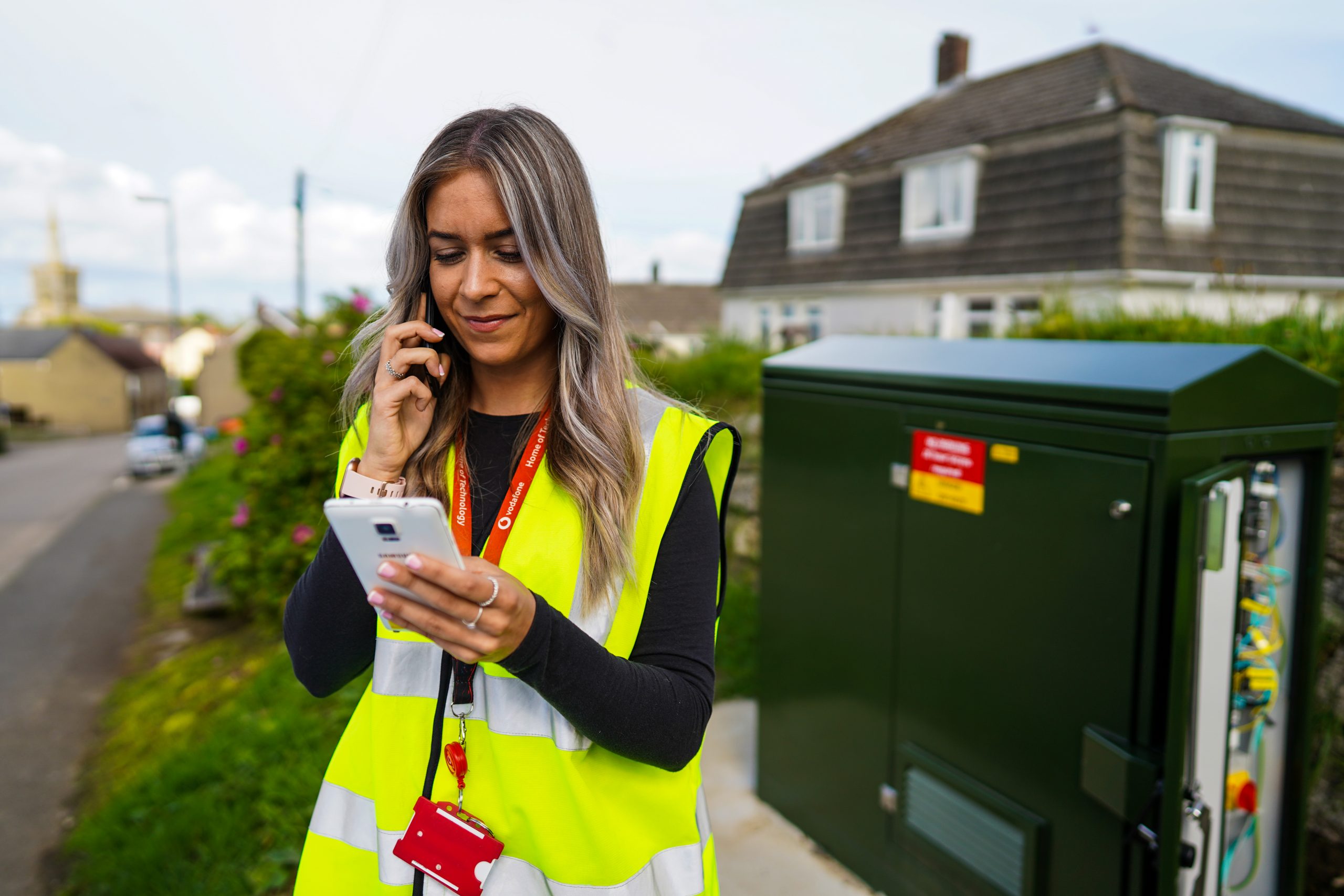ITN's coverage of the Coronation of King Charles III will be the first UK broadcast enabled by a public 5G SA network.
- Coronation broadcast is first in the UK to be enabled by a public 5G Standalone (5G SA) network – the next generation of 5G currently being piloted by Vodafone.
- Vodafone and ITN have entered a partnership to create a network slice on Vodafone’s public 5G SA network for the Coronation TV broadcast.
- This is the first time 5G SA on a public network is being used to enable a broadcast in the UK.
- Vodafone was the first UK network to make 5G SA available to the public, during its pilot in January 2023.
- Partnership formed via Vodafone and Coventry University’s 5G SA Media Lab.
The Coronation of His Majesty King Charles III will be the first time in the UK a public 5G Standalone (5G SA) network is used for a broadcast, due to an innovative partnership between Vodafone and ITN.
Vodafone has worked with ITN to dedicate a slice of Vodafone’s public 5G SA network for the broadcast of the Coronation – the first time any UK telco has provided a slice of its public 5G SA network for a major event broadcast.
Vodafone was the first UK telco to test its 5G SA network for public use in January 2023, when select consumers trialled the new network’s capabilities. Dedicating an exclusive slice of Vodafone’s public 5G SA network to ITN will enable the swift and secure transfer of the live Coronation broadcast coverage from Westminster to ITN’s HQ newsroom in Gray’s Inn Road, London, so it can then be shared across the nation and then worldwide.
Vodafone launches 5G Standalone Mobile Private Network solution
Nick Gliddon, UK Business Director, Vodafone, said: “This innovative partnership will make the Coronation of HM King Charles III the first 5G SA coronation. We are proud to be working with ITN to play our part in helping make this special event happen.
“Innovation is at the heart of Vodafone, from the first text message to the first mobile call, we have been central in the UK’s adoption of digital technology. Now we are continuing this tradition by being the first to switch on 5G SA for the public to trial and providing a slice of this network for the Coronation.
“The possibilities with 5G SA are very exciting – AI, autonomous vehicles, holographic calls, IoT and more. 5G SA will turbo-charge the UK’s digital economy and pave the way for our next digital age.”
Jon Roberts, Director of Television, Production and Innovation at ITN, says: “It feels fitting that 70 years on from the 1953 Coronation, itself a milestone in outside broadcasting, ITN will be delivering coverage to audiences around the world while trialling the future of cellular connectivity.
“We are proud of our role in broadcasting this historic event, and excited to be blazing a trail in partnership with Vodafone as we explore the capabilities of 5G SA technology together.”
Network slicing: Everything you need to know
Network slicing is a new capability enabled by 5G SA, the next generation of 5G, which the UK Government recently called the “cornerstone of the UK’s digital economy”. One of its key benefits is that it allows telecoms operators to create separate and isolated networks for different use cases. Each slice can be configured differently. As they are isolated from each other, the performance on one would not impact another.
In the broadcasting industry, this is an exciting development for two reasons. Firstly, a minimum upload speed threshold can be set to guarantee that digitally dense content is uploaded quickly and reliably for live streaming.
Secondly, it removes the risk of network congestion impacting the performance of the broadcast. This is particularly relevant for mass events such as the Coronation, as well as for live content contribution in isolated locations.
As media organisations become increasingly reliant on mobile networks for outside broadcasts, achieving predictable network performance has become essential. Mobile private networks are a commonly used technology, but these can require heavy-duty equipment. They are also time-consuming, as advance planning is needed to get permission for a private network.
Network slicing gives broadcasters private mobile network for video transmission with no extra heavy-duty equipment, planning, back-office or spectrum licensing needed, and it can be accessed all via a SIM card.
Vodafone and Coventry University launch UK’s first 5G SA Media Innovation Lab
The testing of the capability for this partnership was supported by Vodafone’s technology partner Ericsson and ITN’s technology partner LiveU. This was done at Vodafone and Coventry University’s 5G SA Media Innovation Lab in Coventry – the first of its kind in the UK. Broadcasters and other media companies, as well as the software development community, have been invited to the lab to develop 5G SA use cases for the media industry, working alongside Vodafone engineers and Coventry University academics. The lab supports proof of concepts and allows development and testing of end-to-end solutions in a safe and configurable environment.
Stay up-to-date with the very latest news from Vodafone by following us on Twitter and signing up for News Centre website notifications.
-Ends-
Notes to Editors
What is the difference between 5G Standalone and 5G Non-standalone?
5G Non-standalone is when 5G radios sit on an existing 4G network. It offers speed upgrades, but is still limited in performance by the underlying 4G infrastructure.
5G Standalone is an end-to-end 5G solution, from the core to the radio units. This upgraded infrastructure enables telecoms operators to realise the benefits of 5G which have been spoken about at length for many years, such as low-latency capabilities, for example, as well as introducing new services such as network slicing.
5G Standalone: Unlocking the true power of digital
What is latency?
By installing specialist servers either with Vodafone or at customer facilities, applications are able to respond to commands significantly faster. This time that applications take to respond, known as latency, is a barrier for next-generation innovations that require almost instantaneous reactions, or are powered by artificial intelligence. When combined with 5G, latency could be reduced to speeds faster than those at which the human brain processes information.
What is network slicing?
Network slicing is a service made possible by deploying a 5G Core in the network.
In short, network slicing capabilities allow telecoms operators to create virtual network slices. These network slices are contained and isolated network environments, allowing telecoms operators to customise its performance parameters for customers.
In practice, a certain percentage of the available spectrum is dedicated to creating numerous slices, while the rest is available for general use as it always has been. As 5G connectivity is more efficient than 4G (greater spectral efficiency means improved bandwidth and capacity, so more data can be transmitted at a faster rate), the general public won’t see any impact on network performance when using their devices.
What other network slicing use cases are there?
- Mobile gaming: Today’s real-time multiplayer games require low-latency performance to guarantee a high-quality experience. A maximum threshold for latency and jitter can be applied to specialised network slices to ensure the gaming applications react in near-real time.
- Upgraded performance for short periods of time: customers could “upgrade” performance for a short period of time. For example, increased download speeds to download video content ahead of a plane trip.
- In-venue experience: Connectivity for customers at entertainment venues can be a frustrating experience because of the high concentration of people in a small area. However, as demand at these venues is not 24/7, it could make more commercial sense to deploy a high-bandwidth and high-capacity network slice to ensure customers at mass attendance events have suitable connectivity coverage.
- Automotive: For self-driving or remotely operated vehicles, enhanced and ultra-reliable connectivity is critical for both performance and safety. Specialised network slices could enable tele-operated/self-driving vehicles and real-time situational awareness. Network slicing also guarantees a certain level of Quality of Service to meet specific security needs that might be a regulatory requirement.
- Healthcare: Use cases include remote assessment of potentially life-threatening conditions through video where a low-latency slice could be critical for video performance, as well as using robotics for rehabilitation with real-time control.
- Smart city (public safety): Use cases include real-time smart surveillance, massive mission critical IoT (such as connectivity for electricity grid substations) and real-time location information for emergency services. As each of these use cases could impact the safety of the general public, it would be advantageous to have a specialised network slice, rather than using the public internet (a homogenous connectivity experience).
- Smart city (massive IoT): Deploy new, low-energy and cost-effective sensors at scale (smart electricity sensors for example), with network capacity adjusted to meet demand.
About ITN
ITN is an independent production company with over 67 years’ experience in public service broadcasting and is renowned for being able to deliver journalism of the highest standard across all output.
ITN’s business is made up of seven distinct divisions – Business, Education, Newsrooms (ITV News, Channel 4 News and 5 News), News Production, Productions, Post Production, and Sport – with output ranging from award-winning factual content for major brands, digital platforms and global streamers including Netflix and Amazon and international broadcasters; a vast live sport operation; award-winning news programmes for ITV, Channel 4 and Channel 5; respected live debate programmes; education programming; shortform content and hybrid events for charities and businesses; while ITN’s 60-edit suite facility supports every facet of video and audio post-production. In addition, the ITN Archive features more than a million video clips of iconic news footage from ITN’s first broadcasts in 1955 to the present day.
Click on the link for more on ITN’s coverage of the Coronation.




